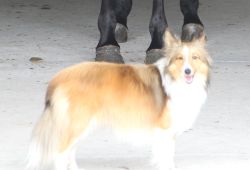Whether in the shop, barn, field, or even the backyard, it is the horseman’s job to keep the farrier as safe as possible.
When the horseshoer is at work on the hoof, he is, for the most part, completely engaged mentally and physically. While your farrier is working in close quarters with the horse, it is impossible to keep tabs on the immediate surroundings and other creatures. The immediate environment should be kept free of potential hazards to that particular horse’s mental state and stability.
I recently spoke with a fellow farrier who was injured badly because a dog ran under the horse he was working on. Even a horse that he fully trusted hurt him, when surprised. He was knocked unconscious and suffered a severe concussion, facial fractures, and deep bruises all over. That’s too big a price to pay for carelessness.
Certainly there is fault on both sides. Sometimes, we, as farriers, concede to riskier situations simply to get the job done. I have done so myself. But, if we are to do our best job, it is not possible to keep one eye on the horse and the other on everything else in the environment.
While a person is holding the horse, it is a much safer situation if that person is mindful of the things that affect the horse and, consequently, the farrier. It may seem meaningless that a horse is throwing its head around, but this has quite an impact on the farrier holding and supporting a leg up while this is happening. I mention this because when something as tame as tossing a head affects us (those who are working below the girth) greatly it means scared, quick, reactive movements from the horse can have dire consequences. This may seem a bit picky, but the situation with the dog I described earlier could easily have killed that man. In fact, it almost did.
Farriers are also animal lovers; we almost have to be to keep doing the profession a long time. Most of us have our own pets at home. It is just not a great idea to have them running around the horse when we work.
 (Mark Hall photo) Fig. 1: Some pets, like the Linds' Kramer, understand to stay outside of the farrier shop.
(Mark Hall photo) Fig. 1: Some pets, like the Linds' Kramer, understand to stay outside of the farrier shop.
There are definitely places that I trust completely. Fig. 1 is a photo of Kramer, a dog owned by Staffan and Marie Lind. She waited quietly and patiently outside the shop. She just plopped herself down and did not enter. If all pets were like Kramer, there would never be a problem.
The unpredictability of having too many animals in the work area with a horse creates added risk. People (non-horsemen) are hard enough to predict, considering trucks, lawn mowers, weed-eaters, tractors etc. I very much appreciate a man like Donnie Searl from Red Mile who “gave me a brake” every time he drove by the shop door.
As farriers, we willingly accept the inherent risk of the job. Adding to that risk unnecessarily is, to use a football term, “piling on.” Any farrier who has been working for a long time has been injured and knows it may happen any time. We accept that. Most of us just don’t want to ask for it, doggone it.
Veteran Standardbred farrier Steve Stanley of Lexington, Ky., authors a monthly column for Hoof Beats, the official harness racing publication of the U.S. Trotting Association. The American Farriers Journal Editorial Advisory Board member offers plenty of practical advice that will be of special interest regardless of the type of horses that you work with. Click here to read more from Steve Stanley's Hoof Beats series.








Post a comment
Report Abusive Comment